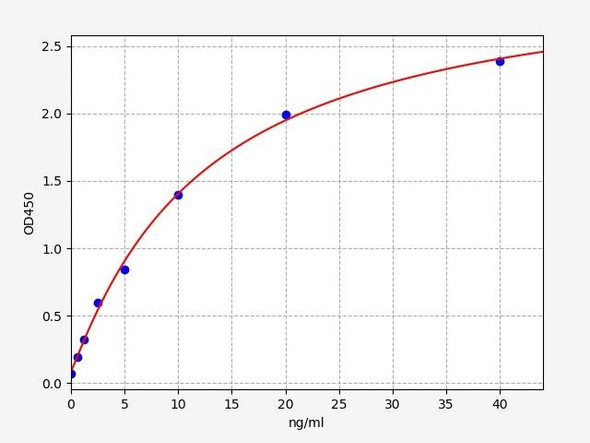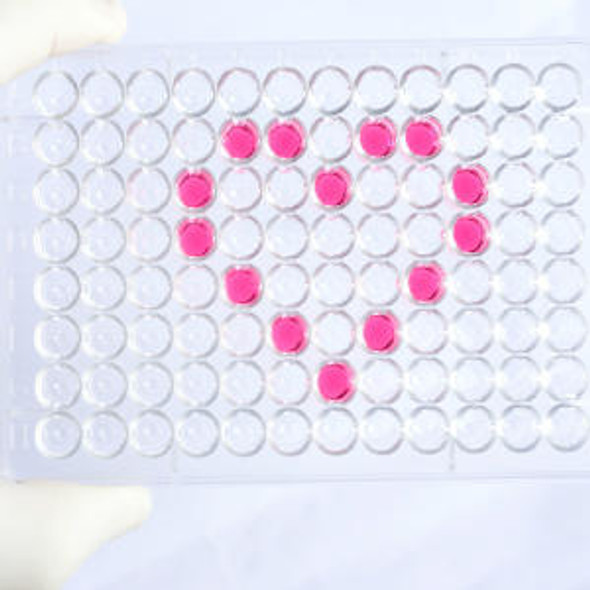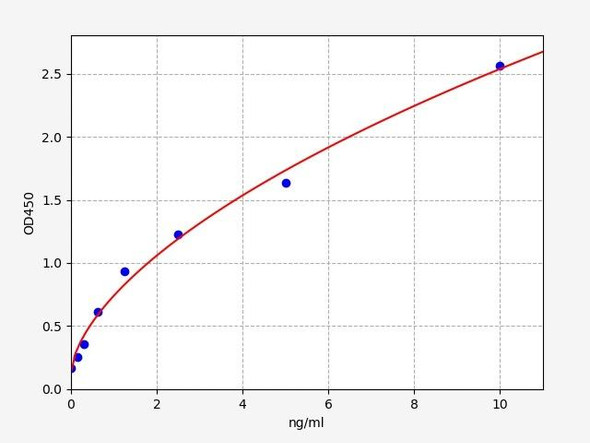Rat PCSK9 / Proprotein Convertase 9 ELISA Kit
- SKU:
- RTFI00078
- Product Type:
- ELISA Kit
- Size:
- 96 Assays
- Uniprot:
- P59996
- Sensitivity:
- 9.375pg/ml
- Range:
- 15.625-1000pg/ml
- ELISA Type:
- Sandwich ELISA, Double Antibody
- Synonyms:
- Pcsk9, Proprotein Convertase Subtilisin, Kexin Type 9, Proprotein Convertase 9, FH3, HCHOLA3, NARC-1, PC9, HCHOLA3, LDLCQ1
- Reactivity:
- Rat
Description
| Product Name: | Rat Pcsk9 (Proprotein convertase subtilisin/kexin type 9) ELISA Kit |
| Product Code: | RTFI00078 |
| Size: | 96 Assays |
| Target: | Rat Pcsk9 |
| Alias: | Pcsk9, Proprotein Convertase Subtilisin, Kexin Type 9, Proprotein Convertase 9, FH3, HCHOLA3, NARC-1, PC9, HCHOLA3, LDLCQ1 |
| Reactivity: | Rat |
| Detection Method: | Sandwich ELISA, Double Antibody |
| Sensitivity: | 9.375pg/ml |
| Range: | 15.625-1000pg/ml |
| Storage: | 4°C for 6 months |
| Note: | For Research Use Only |
| Recovery: | Matrices listed below were spiked with certain level of Rat Pcsk9 and the recovery rates were calculated by comparing the measured value to the expected amount of Rat Pcsk9 in samples. | ||||||||||||||||
| |||||||||||||||||
| Linearity: | The linearity of the kit was assayed by testing samples spiked with appropriate concentration of Rat Pcsk9 and their serial dilutions. The results were demonstrated by the percentage of calculated concentration to the expected. | ||||||||||||||||
| |||||||||||||||||
| Intra-Assay: | CV <8% | ||||||||||||||||
| Inter-Assay: | CV <10% |
| Uniprot: | P59996 |
| UniProt Protein Function: | PCSK9: Crucial player in the regulation of plasma cholesterol homeostasis. Binds to low-density lipid receptor family members: low density lipoprotein receptor (LDLR), very low density lipoprotein receptor (VLDLR), apolipoprotein E receptor (LRP1/APOER) and apolipoprotein receptor 2 (LRP8/APOER2), and promotes their degradation in intracellular acidic compartments. Acts via a non-proteolytic mechanism to enhance the degradation of the hepatic LDLR through a clathrin LDLRAP1/ARH-mediated pathway. May prevent the recycling of LDLR from endosomes to the cell surface or direct it to lysosomes for degradation. Can induce ubiquitination of LDLR leading to its subsequent degradation. Inhibits intracellular degradation of APOB via the autophagosome/lysosome pathway in a LDLR-independent manner. Involved in the disposal of non-acetylated intermediates of BACE1 in the early secretory pathway. Inhibits epithelial Na(+) channel (ENaC)-mediated Na(+) absorption by reducing ENaC surface expression primarily by increasing its proteasomal degradation. Regulates neuronal apoptosis via modulation of LRP8/APOER2 levels and related anti-apoptotic signaling pathways. Defects in PCSK9 are the cause of hypercholesterolemia autosomal dominant type 3 (HCHOLA3). A familial condition characterized by elevated circulating cholesterol contained in either low-density lipoproteins alone or also in very-low-density lipoproteins. Belongs to the peptidase S8 family. 2 isoforms of the human protein are produced by alternative splicing. |
| UniProt Protein Details: | Protein type:Cell development/differentiation; EC 3.4.21.-; Protease; Secreted; Secreted, signal peptide Chromosomal Location of Human Ortholog: 5q34 Cellular Component: cell surface; COPII-coated ER to Golgi transport vesicle; cytoplasm; early endosome; endoplasmic reticulum; extracellular region; extracellular space; Golgi apparatus; late endosome; lysosome; perinuclear region of cytoplasm; plasma membrane; rough endoplasmic reticulum Molecular Function:apolipoprotein binding; apolipoprotein receptor binding; low-density lipoprotein particle binding; low-density lipoprotein receptor binding; protein self-association; receptor inhibitor activity; RNA binding; serine-type endopeptidase activity; sodium channel inhibitor activity; very-low-density lipoprotein binding Biological Process: apoptosis; cellular response to insulin stimulus; cellular response to starvation; cholesterol homeostasis; cholesterol metabolic process; kidney development; lipoprotein metabolic process; liver development; low-density lipoprotein particle receptor catabolic process; low-density lipoprotein receptor particle metabolic process; lysosomal transport; negative regulation of receptor recycling; neurogenesis; neuron differentiation; phospholipid metabolic process; positive regulation of low-density lipoprotein particle receptor catabolic process; positive regulation of neuron apoptotic process; positive regulation of receptor internalization; protein autoprocessing; protein processing; regulation of low-density lipoprotein receptor catabolic process; regulation of neuron apoptosis; regulation of receptor activity; triacylglycerol metabolic process |
| NCBI Summary: | a soluble zymogen; involved in hepatic growth and differentiation [RGD, Feb 2006] |
| UniProt Code: | P59996 |
| NCBI GenInfo Identifier: | 77020250 |
| NCBI Gene ID: | 298296 |
| NCBI Accession: | NP_954862.2 |
| UniProt Secondary Accession: | P59996,Q5I6U6, |
| UniProt Related Accession: | P59996 |
| Molecular Weight: | 74,709 Da |
| NCBI Full Name: | proprotein convertase subtilisin/kexin type 9 |
| NCBI Synonym Full Names: | proprotein convertase subtilisin/kexin type 9 |
| NCBI Official Symbol: | Pcsk9 |
| NCBI Official Synonym Symbols: | PC9; Narc1; NARC-1 |
| NCBI Protein Information: | proprotein convertase subtilisin/kexin type 9 |
| UniProt Protein Name: | Proprotein convertase subtilisin/kexin type 9 |
| UniProt Synonym Protein Names: | Neural apoptosis-regulated convertase 1; NARC-1; Proprotein convertase 9; PC9; Subtilisin/kexin-like protease PC9 |
| Protein Family: | Proprotein convertase subtilisin/kexin |
| UniProt Gene Name: | Pcsk9 |
| Step | Procedure |
| 1. | Set standard, test sample and control (zero) wells on the pre-coated plate respectively, and then, record their positions. It is recommended to measure each standard and sample in duplicate. Wash plate 2 times before adding standard, sample and control (zero) wells! |
| 2. | Aliquot 0.1ml standard solutions into the standard wells. |
| 3. | Add 0.1 ml of Sample / Standard dilution buffer into the control (zero) well. |
| 4. | Add 0.1 ml of properly diluted sample ( Human serum, plasma, tissue homogenates and other biological fluids.) into test sample wells. |
| 5. | Seal the plate with a cover and incubate at 37°C for 90 min. |
| 6. | Remove the cover and discard the plate content, clap the plate on the absorbent filter papers or other absorbent material. Do NOT let the wells completely dry at any time. Wash plate X2. |
| 7. | Add 0.1 ml of Biotin- detection antibody working solution into the above wells (standard, test sample & zero wells). Add the solution at the bottom of each well without touching the side wall. |
| 8. | Seal the plate with a cover and incubate at 37°C for 60 min. |
| 9. | Remove the cover, and wash plate 3 times with Wash buffer. Let wash buffer rest in wells for 1 min between each wash. |
| 10. | Add 0.1 ml of SABC working solution into each well, cover the plate and incubate at 37°C for 30 min. |
| 11. | Remove the cover and wash plate 5 times with Wash buffer, and each time let the wash buffer stay in the wells for 1-2 min. |
| 12. | Add 90 µL of TMB substrate into each well, cover the plate and incubate at 37°C in dark within 10-20 min. (Note: This incubation time is for reference use only, the optimal time should be determined by end user.) And the shades of blue can be seen in the first 3-4 wells (with most concentrated standard solutions), the other wells show no obvious color. |
| 13. | Add 50 µL of Stop solution into each well and mix thoroughly. The color changes into yellow immediately. |
| 14. | Read the O.D. absorbance at 450 nm in a microplate reader immediately after adding the stop solution. |
When carrying out an ELISA assay it is important to prepare your samples in order to achieve the best possible results. Below we have a list of procedures for the preparation of samples for different sample types.
| Sample Type | Protocol |
| Serum: | If using serum separator tubes, allow samples to clot for 30 minutes at room temperature. Centrifuge for 10 minutes at 1,000x g. Collect the serum fraction and assay promptly or aliquot and store the samples at -80°C. Avoid multiple freeze-thaw cycles. If serum separator tubes are not being used, allow samples to clotovernight at 2-8°C. Centrifuge for 10 minutes at 1,000x g. Removeserum and assay promptly or aliquot and store the samples at-80°C. Avoid multiple freeze-thaw cycles. |
| Plasma: | Collect plasma using EDTA or heparin as an anti-coagulant. Centrifuge samples at 4°C for 15 mins at 1000 — g within 30 mins of collection. Collect the plasma fraction and assay promptly or aliquot and store the samples at -80°C. Avoid multiple freeze-thaw cycles.Note: Over haemolysed samples are not suitable for use with this kit. |
| Urine & Cerebrospinal Fluid: | Collect the urine (mid-stream) in a sterile container, centrifuge for 20 mins at 2000-3000 rpm. Remove supernatant and assay immediately. If any precipitation is detected, repeat the centrifugation step. A similar protocol can be used for cerebrospinal fluid. |
| Cell Culture Supernatant: | Collect the cell culture media by pipette, followed by centrifugation at 4°C for 20 mins at 1500 rpm. Collect the clear supernatant and assay immediately. |
| Cell Lysates: | Solubilize cells in lysis buffer and allow to sit on ice for 30 minutes. Centrifuge tubes at 14,000 x g for 5 minutes to remove insoluble material. Aliquot the supernatant into a new tube and discard the remaining whole cell extract. Quantify total protein concentration using a total protein assay. Assay immediately or aliquot and store at ≤ -20°C. |
| Tissue Homogenates: | The preparation of tissue homogenates will vary depending upon tissue type. Rinse tissue with 1X PBS to remove excess blood & homogenizein 20ml of 1X PBS (including protease inhibitors) and store overnight at ≤ -20°C. Two freeze-thaw cycles are required to break the cell membranes. To further disrupt the cell membranes you can sonicate the samples. Centrifuge homogenates for 5 mins at 5000xg. Remove the supernatant and assay immediately or aliquot and store at -20°C or-80°C. |
| Tissue Lysates: | Rinse tissue with PBS, cut into 1-2 mm pieces, and homogenize with a tissue homogenizer in PBS. Add an equal volume of RIPA buffer containing protease inhibitors and lyse tissues at room temperature for 30 minutes with gentle agitation. Centrifuge to remove debris. Quantify total protein concentration using a total protein assay. Assay immediately or aliquot and store at ≤ -20 °C. |
| Breast Milk: | Collect milk samples and centrifuge at 10,000 x g for 60 min at 4°C. Aliquot the supernatant and assay. For long term use, store samples at -80°C. Minimize freeze/thaw cycles. |









